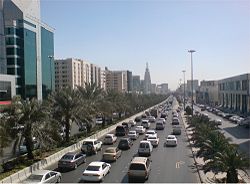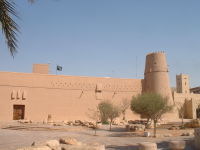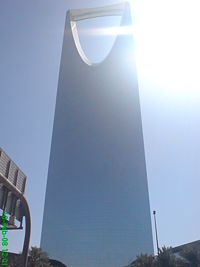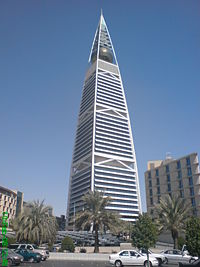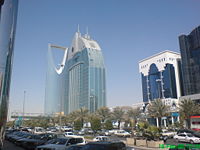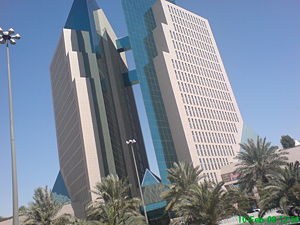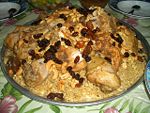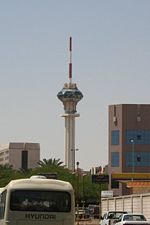Riyadh
2008/9 Schools Wikipedia Selection. Related subjects: Geography of the Middle East
Coordinates:
| City of Riyadh | |||
| A part of King Fahd Road | |||
|
|||
| Nickname(s): Riyadh | |||
| Location of Riyadh | |||
| Coordinates: | |||
|---|---|---|---|
| Country | |||
| Province | Riyadh Province | ||
| Established | Unknown | ||
| Capital of Second Saudi State | 1824-1891 | ||
| Capital of Saudi Arabia | 1902, 1932 (officially) | ||
| Government | |||
| - Mayor | Abdul Aziz ibn 'Ayyaf Al Migrin | ||
| - Provincial Governor | Prince Salman Bin Abdul Aziz | ||
| Area | |||
| - Urban | 1,000 km² (386.1 sq mi) | ||
| - Metro | 1,554 km² (600 sq mi) | ||
| Population (2007) | |||
| - City | 4,700,000 | ||
| - Density | 2,921/km² (1,826/sq mi) | ||
| - Urban | 4,853,912 | ||
| - Metro | 5,188,000 | ||
| Riyadh Development Authority estimate | |||
| Time zone | EAT ( UTC+3) | ||
| - Summer ( DST) | EAT ( UTC+3) | ||
| Postal Code | (5 digits) | ||
| Area code(s) | +966-1 | ||
| Website: www.arriyadh.com | |||
Riyadh (Arabic: الرياض Ar-Riyāḍ) is the capital of Saudi Arabia and its largest city. It is also the capital of Riyadh Province, and belongs to the historical regions of Nejd and Al-Yamama. It is situated in the centre of the Arabian Peninsula on a large plateau, and is home to over 4,260,000 people.
The city is divided into 15 municipal districts, managed by Riyadh Municipality headed by the mayor of Riyadh, and the Riyadh Development Authority, chaired by Governor of Riyadh Province, Prince Salman bin Abdulaziz.
The current mayor of Riyadh is Abdul Aziz ibn Ayyaf Al Migrin, appointed in 1998.
Name
The name Riyadh is derived from the plural of the Arabic word rawdha, which means "garden," particularly those formed in the desert after the spring rains. Riyadh has for more than 1500 years been a fertile area set in the heartland of the Arabian Peninsula. The settlement was historically famous for its Palm Trees and Dates and Orchards. The modern name was first applied to only certain parts of the settlement where orchards predominated. Gradually the name was used for the entire settlement.
History
Early History
During the Pre-Islamic era, the settlement at the site was called Hajr (Arabic: حجر), And was reportedly founded by the tribe of Banu Hanifa. Hajr served as the capital of the province of Al Yamamah, Whose governors were responsible for most of central and eastern Arabia during the Umayyad and Abbasid eras. Al-Yamamah broke away from the Abbasid Empire in 866 and the area fell under the rule of the Ukhaydhirites, who moved the capital from Hajr to nearby Al Kharj. The city then went into a long period of decline. In the 14th century North African traveller Ibn Battuta wrote of his visit to Hajr, describing it as "the main city of Al-Yamamah, and its name is Hajr". Ibn Battuta goes on to describe it as a city of canals and trees with most of its inhabitants belongs to Bani Hanifa, and reports that he continued on with their leader to Mecca to perform the Hajj.
Later on, Hajr broke up into several separate settlements and estates. The most notable of these were Migrin (or Muqrin) and Mi'kal, though the name Hajr continued to appear in local folk poetry. The earliest known reference to the area by the name Riyadh comes from a 17th-century chronicler reporting on an event from the year 1590.
In 1737, Deham ibn Dawwas, a refugee from neighboring Manfuha, took control of Riyadh. Ibn Dawwas built a single wall to encircle the various quarters of Riyadh, making them effectively a single town.
The three Saudi States
In 1744, Muhammad ibn Abdel Wahhab formed an alliance with Muhammad ibn Saud, The ruler of the nearby town of Diriyah. Ibn Saud then set out to conquer the surrounding region with the goal of bringing it under the rule of a single Islamic state. Ibn Dawwas of Riyadh led the most determined resistance, Allied with forces from Al Kharj, Al Ahsa, And the Banu Yam clan of Najran.
However, Ibn Dawwas fled and Riyadh capitulated to the Saudis in 1774. Ending long years of wars. and declaring the First Saudi State.
The First Saudi State was destroyed by forces sent by Muhammad Ali of Egypt, acting on behalf of the Ottoman Empire. Ottoman forces razed the Saudi capital Diriyah in 1818. In 1823, Turki ibn Abdallah, the founder of the Second Saudi State, revived the state and chose Riyadh as the new capital.
Internecine struggles between Turki's grandsons led to the fall of the Second Saudi State in 1891 at the hand of the rival Al Rashid clan, who ruled from the northern city of Ha'il. Riyadh itself fell under the rule of Al Rashid in 1865. The al-Masmak fort dates from this period.
The city was recaptured in 1902 from the Al Rashid family by King Abdulaziz Ibn Saud. He went on to establish the modern Kingdom of Saudi Arabia in 1932, with Riyadh the capital of the nation.
Geography
Population
The city has experienced very high rates of population growth, which is indicated by the poor quality of development since the 1970s. In the 1960s, its population was 50,000. According to most recent sources, today it is home to over 4.5 million inhabitants.
| Year | Population |
|---|---|
| 1862 | 7,500 |
| 1935 | 30,000 |
| 1960 | 150,000 |
| 1970 | 370,000 |
| 1972 | 500,000 |
| 1974 | 650,000 |
| 1988 | 1,500,000 |
| 1990 | 2,000,000 |
| 1997 | 2,800,000 |
| 2008 | 5,100,000 |
Climate
Summer temperatures are very hot, frequently exceeding 45 ℃ (113 ℉). Winters are mild with cool nights. Although the city is located in a highly arid area, It receives some rainfall. Hail occasionally falls in Riyadh during winters.
| Riyadh Climatological Data | ||||||||||||||
|---|---|---|---|---|---|---|---|---|---|---|---|---|---|---|
| Month | Jan | Feb | Mar | Apr | May | Jun | Jul | Aug | Sep | Oct | Nov | Dec | Year | |
| Record high °C | 30 | 33 | 38 | 40 | 43 | 45 | 45 | 44 | 44 | 38 | 34 | 31 | ||
| Average high °C | 21 | 23 | 28 | 32 | 38 | 42 | 42 | 42 | 39 | 34 | 29 | 21 | 33 | |
| Record low °C | -7 | -2 | 1 | 2 | 15 | 19 | 19 | 17 | 17 | 10 | 2 | 0 | ||
| Average low °C | 8 | 9 | 13 | 18 | 22 | 25 | 26 | 24 | 22 | 16 | 13 | 9 | 17 | |
| Rainfall mm | 3 | 20 | 21 | 22 | 10 | 0 | 0 | 0 | 0 | 0 | 0 | 0 | 76 | |
City districts
Riyadh is divided into 15 municipalities, in addition to the Diplomatic Quarter, while on its northwestern outskirts lay the ruins of the former Saudi capital of Diriyah. Each municipal district contributes in its own way to the character of the city.
The bustling Olaya District is the commercial heart of the city. This commercial and residential district offers accommodation, entertainment, dining and shopping options. The Kingdom Centre, Al Faisalyah and Al-Tahlya Street are the area's most prominent landmarks.
The Diplomatic Quarter, or DQ as it is popularly known, is home to foreign embassies and international organizations as well as residential structures and malls. With lush gardens and numerous sports facilities, it is also one of the city's greenest areas. It is especially known for its fine architecture, and is considered a model for other Islamic cities around the world. Despite its name, the Diplomatic Quarter offers no special privileges. All Saudi laws must be obeyed and there are occasional patrols by the Mutaween, or Saudi religious police.
The centre of the city, Al-Bathaa and Al-Dirah, is also its oldest part. At its heart lies the 19th-century Al Masmak fort, which is one of the city's major attractions; to the west lies the Riyadh Museum of History and Archeology and the Murabba' Palace, an old residence of first Saudi king, Ibn Saud, now a museum. The Qasr Al-Hukm, or Palace of Justice, is nearby. It is here that the Governor of Riyadh Province meets citizens, listens to their grievances and problems, and stays abreast of all aspects of the region's life. The Al-Dira area also contains commercial markets and traditional buildings, such as the Al-Mu'eiqilia market and the city's Grand Mosque.
Landmarks
Old Riyadh
The old town includes Diriyah, King Abdulaziz district, Wadi Laban and many other historical villages which became a part of the city. It had a lot of amazing traditional multistory buildings, but lost ground to more modern development and giant business projects. However, the city's recent generations have come to appreciate its traditions more and have persevered in having many of the older buildings carefully preserved. Some of these structures are Al Masmak Castle and Qasr Al Hokom.
Landmarks
Burj Al Mamlakah
Kingdom Tower (Arabic: برج المملكة) in Riyadh is the tallest skyscraper in Saudi Arabia. With a height of 302 m (992 ft), it is the 37th tallest building in the world. The tower is built on area of 94,230 square meters of land, while the whole centre is built on a total area of 300,000 square meters. The tower is host to the highest mosque in the world.
The Kingdom Centre is owned by Al-Waleed bin Talal, a prince of the Saudi royal family. It is also the headquarters of his holding company: Kingdom Holding Company. The total cost of the project was 1.717 billion Saudi Arabian Riyals and the contract was taken by Saudi Arabian El Saif and the Italian Impregilo S.p.A. Kingdom Center is situated in Al-Urubah Road between King Fahd Road and Olaya Street in the growing business district of Al-Olaya in Riyadh. Kingdom Centre was the winner of the 2002 Emporis Skyscraper Award, selected as the "best new skyscraper of the year for design and functionality". A three-level shopping centre, which also won a major design award, fills the east wing. The large opening is illuminated at night in continuously changing colors.
Burj Al Faisaliyah
Al Faisaliyah Centre (Arabic: برج الفيصلية) was the first skyscraper constructed in Saudi Arabia, and the second tallest building in the country after the Kingdom Centre. The golden ball that lies atop the tower is said to be inspired by a ballpoint pen. Inside the ball is a restaurant, immediately below it an outside viewing deck at ground level, there is a shopping centre with major world brands.
Burj Al Anoud Al Anoud tower is a major commercial building on King Fahd road, with a height of 145 m. There is plans to build another similar tower beside the current tower with the same name. The tower is owned by Princess Al-Anoud and moderated by several Saudi Arabian companies.
Riyadh TV Tower
The Riyadh TV Tower is a 170 metre high television tower with an observation deck at Riyadh, Saudi Arabia. The tower was built between 1978 and 1981.
Ministry of Interior Building
The main building of Ministry of Interior of Saudi Arabia which is located in Riyadh, Can be considered as one of Riyadh most beautiful landmarks with its unique design.
Al Masmak Castle
This castle was built around 1865 under the reign of Mohammed ibn Abdullah ibn Rasheed (1289-1315 AH), the ruler of Ha'il to the north, who had wrested control of the city from the rival clan of Al Saud. In January 1902 Ibn Saud, who was at the time living in exile in Kuwait succeeded in capturing the Masmak fortress from its Rashid garrison. The event, which restored Al Saud control over Riyadh, has acquired almost mythical status in the history of Saudi Arabia and has been retold many times, but has as its central theme the heroism and bravery of the future King Abd Abdulaziz Ibn Saud.
Embassies
Riyadh hosts 50 embassies , 22 embassies belong to the states of the Arab League. Along with embassies of Austria, Australia, Bangladesh,Bosnia and Herzegovina, Brunei, Canada, China, Czech Republic, Denmark, France, Germany, Greece, India, Indonesia, Iran, Italy, Japan, Malaysia, the Netherlands, Niger, Nigeria, Norway, Pakistan, Philippines, Poland, Russia, Singapore, South Korea, South Africa, Spain, Sweden, Turkey, United Kingdom, United States of America.
Economy
Once a small walled city, Riyadh has developed into a dynamic metropolis over the years. Along with the urban areas of Dhahran, Dammam and Khobar, Riyadh has become a focal point for both travel and trade.
In addition to being the centre of power, the city is also a commercial hub. Numerous educational, financial, agricultural, cultural, technical, and social organizations have set up base here. The architecture is mostly modern, including contemporary high-rise towers, but the Al-Dira district, the nucleus of the city, has been rebuilt in a style meant to evoke the old mud-brick buildings of pre-20th century Nejd.
Since beginning of oil exploration in Saudi Arabia until nowadays, the government is attempting to promote growth in the private sector by privatizing industries such as power and telecommunications. Saudi Arabia announced plans for privatizing the electricity companies. A lot of these new private conglomerates and companies headquarters are located in Riyadh, along with National Banks headquarters. Because of that, Riyadh can be considered as one of biggest business cities in the Middle East.
King Khalid International Airport, has a major impact on the commercial movement in Riyadh, Providing Air-Transportation for millions of people across a year. And shipping goods to the city from all continents.
King Fahd Road
King Fahd road is the wealthiest business place in Riyadh, Headquarters of major companies and organizations are located on the road's both sides. Huge malls, business towers and skyscrapers are widely distributed on this road.
The northern end reaches the Airport over another highway. According to many opinions, King Fahd Road is the most beautiful street in Saudi Arabia. Which gives the road a tourism value also.
Famous landmarks such as Kingdom Centre, Al Faisaliyah Centre, Al Anoud Tower and the Ministry of Interior building are also located in King Fahd Road.
The Industrial City
The Industrial areas are located on the East and the North-East of the city, Including some of world largest factories of oil-related industry, high-tech, low-tech and agriculture. The headquarter of Aramco, The world largest oil company is located in Dhahran. Electricity and water-treatments plants supply the city with the needed energy and water, which also reach the nearby towns.
Demographic
As a capital of Saudi Arabia, Riyadh has received millions of visitors of different backgrounds from all over the country. The population of Riyadh includes 66% of Saudis along with 34% of foreigners from Africa, Central Asia, Southeast Asia, Europe and the Middle East, many of whom remained and became residents of the city.
Education
Riyadh is home to two public universities and several private universities and colleges.
Universities:
- King Saud University
- Imam Muhammad bin Saud Islamic University
- Prince Sultan University
- Arab Open University
- Al-Faisal University
- King Saud bin Abdulaziz University for Health Sciences
- Riyadh University for Women
- Naif Arab University for Security Sciences
Colleges:
- Al Yamamah College
- Riyadh College of Dentistry and Pharmacy
- Riyadh College of Technology
- College of Telecommunication and Information
- King Faisal College of Aviation - responsible for training the officer corps of the Royal Saudi Air Force.
- King Khalid Military College - responsible for training the officer corps of the Saudi National Guard.
Riyadh also houses the main campus of the Government's Institute of Public Administration and the Saudi Arabian Monetary Agency's Institute of Banking.
Culture
Religious significance
The vast majority of Riyadh residents are Sunni Muslims, with a minority of Asian and Westerner Christians. The city has over 4292 Mosques. The cultural environment of today's Riyadh has been influenced by a religious movement that began in central Arabia in the mid-18th century. This movement is commonly known as the Wahhabi movement.
Cuisine
Like other Saudi cities, the Nejdi Kabsa is the most traditional lunch in Riyadh. The Yemeni Mandi is also popular as a lunch meal.
Fast food is also popular in the city. McDonald's, Burger King, Domino's Pizza and KFC among others are widely distributed in Riyadh.
Sport
Football (Soccer) is the most popular sport in Riyadh. The city hosts four major football clubs, Such as Al Shabab, which was established in 1947, holding a great record in the Saudi Premier League. Al-Nasr club is another famous squad in the league, was named six times as a champion of the Saudi League, and was established in 1955. The well-known club Al-Hilal, Which was established in 1957 conquers the league as the winner of ten championships, is the most popular team in Riyadh. Also, there is Al-Riyadh club, which was established in 1954 along with many other minor clubs.
The city also hosts several giant stadiums, such as King Fahd International Stadium with capacity of 70,000 seats. The stadium hosted the FIFA Confederations Cup three times in 1992, 1995 and 1997. And also the FIFA U-20 World Cup in 1989.
Accent
The Riyadh city area has a distinctive regional speech pattern called the Najdi dialect. It is often considered to be one of the most recognizable accents within the Arabic language. The Najdi accent is widely spoken in the desert regions of central and eastern Saudi Arabia.
Transportation
Airports
Riyadh's King Khalid International Airport ( IATA: RUH), located 35 kilometers north, is the city's main airport. It's one of the four international airports in the country serving over 9 million passengers a year.
Highways
The city is served by a modern major highway system. The main Eastern Ring Road connects the city's south and north, while Northern Ring Road connects the city's east and west. King Fahd Road runs through the center of the city from north to south, in parallel with the East Ring Road. Makkah Road (also known as Khurais Road), which runs east-west across the city's centre, connects eastern parts of the city with the city's main business district and the diplomatic quarters.
Railway
Saudi Railway Authority operates two separate passenger and cargo lines between Riyadh and Dammam passing through Hofuf, and Haradh. Two future railway projects connecting Riyadh with Jeddah and Mecca in the western region and connecting Riyadh with Buraidah, Ha'il and Northern Saudi Arabia are underway. Developers are the RC corporation, wholly owned by H O’Donovan, W Daly and S Burgoyne, however, are now being built single-handedly by H O'Donovan.
Public transport
The Saudi Arabian Public Transport Co. (SAPTCO), the national bus system, runs a fleet of buses that provides public transportation inside the city, and also an extending service transporting passengers to several cities across the kingdom and neighboring countries.
An electric sky train system has been approved and the first phase will be installed in King Abdullah Road, King Fahd Road and Al Olaya Road. It will run for 25km and will include communication services such as phones and internet.
